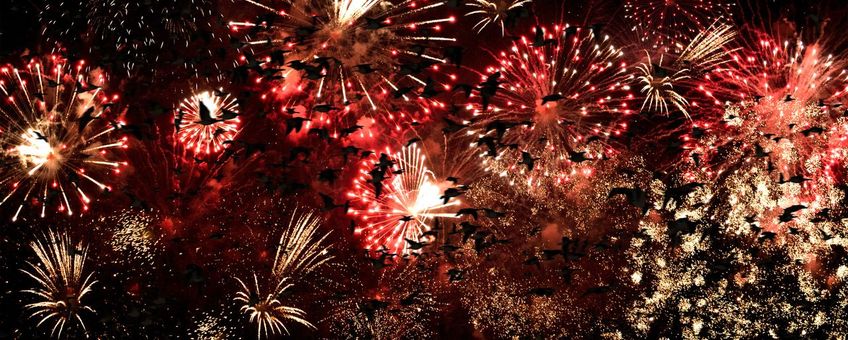
Millions of birds lose precious energy due to fireworks on New Year’s Eve
Institute for Biodiversity and Ecosystem Dynamics (IBED), Sovon Dutch Centre for Field OrnithologyOn New Year's Eve, an average of 1,000 times as many birds are in the air close to where fireworks are set off as on other nights, with peaks of 10,000 to 100,000 times the normal number of birds. The effects are strongest within the first five kilometres of fireworks, but up to ten kilometres there are still an average of at least ten times as many birds flying as normal. Scientists from the Institute for Biodiversity and Ecosystem Dynamics (IBED) from the University of Amsterdam (UvA) published their results in the scientific journal Frontiers in Ecology and the Environment.
"Birds take off as a result of an acute flight response due to sudden noise and light. In a country like the Netherlands, with many wintering birds, we are talking about millions of birds being affected by the lighting of fireworks", says ecologist and first author Bart Hoekstra.
Weather radar and bird counts
Last year, other researchers at IBED discovered that geese are so affected by fireworks that they spend an average of ten percent longer looking for food than normal during at least the next eleven days after New Year's Eve. They apparently need that time to replenish the lost energy or to compensate for the unknown foraging area in which they have ended up, after fleeing from the fireworks.
Hoekstra’s study looked at which species take off after fireworks and when this occurs. He used information from Royal Netherlands Meteorological Institute weather radars during both a clear New Year's Eve and on other normal nights. He combined this with distribution data from Sovon – the Dutch Centre for Field Ornithology – based on bird counts by hundreds of volunteers. "We already knew that many water birds react strongly, but it was still unclear how birds outside these waterbodies react to fireworks. Through the counts we know exactly where which birds are and using the radar images we can see where they actually take off because of fireworks." Using the data, Hoekstra was able to calculate how many birds take off immediately after the start of the fireworks, at what distance from fireworks this happens, and which species groups mainly react.
Panic in the air
The analysis makes it clear that in the study areas around the radars in Den Helder and Herwijnen alone, almost 400,000 birds take off immediately at the start of the fireworks during New Year's Eve. Moreover, it appears that larger birds in open areas in particular fly around for hours after and at remarkable altitudes. Hoekstra: "Larger birds such as geese, ducks and gulls fly to a height of hundreds of metres due to the large-scale discharge of fireworks and remain in the air for up to an hour. There is a risk that they will end up in bad winter weather, or that they will not know where they are flying due to panic and accidents could occur."
"Restrict fireworks in central areas"
Because 62 percent of all birds in the Netherlands live within a radius of 2.5 kilometres of inhabited areas, the consequences of fireworks are high for all birds throughout the country, Hoekstra says. "Flying requires a lot of energy, so ideally birds should be disturbed as little as possible during the cold winter months. Measures to ensure this are especially important in open areas such as grasslands, where many larger birds spend the winter. The effects of fireworks on birds are less pronounced near forests and semi-open habitats. In addition, smaller birds such as tits and finches live there, which are less likely to fly away from disturbance."
The authors argue for fireworks-free zones in areas where large birds live. Hoekstra: "These buffer zones could be smaller in areas where light and sound travel less far, such as near forests. Furthermore, fireworks should mainly be lit at central locations in built-up areas, as far away from birds as possible. It would be best for birds if we moved towards light shows without sound, such as drone shows or decorative fireworks without very loud bangs."
Tekst: IBED
Foto: Pexel/Bart Hoekstra
